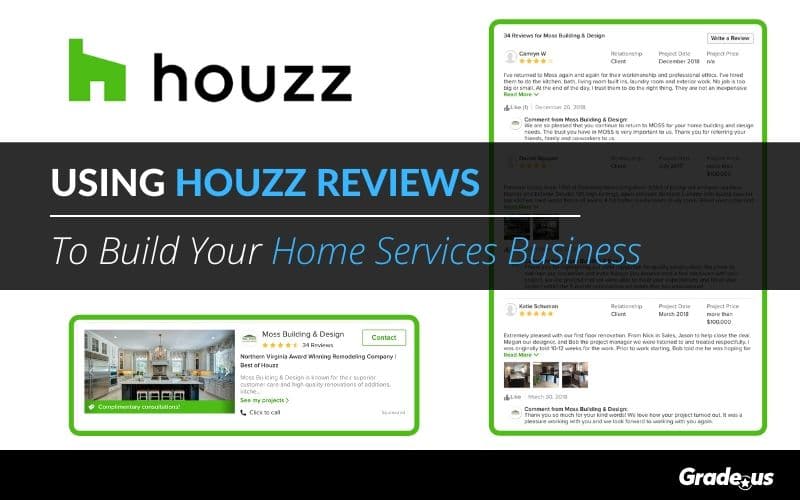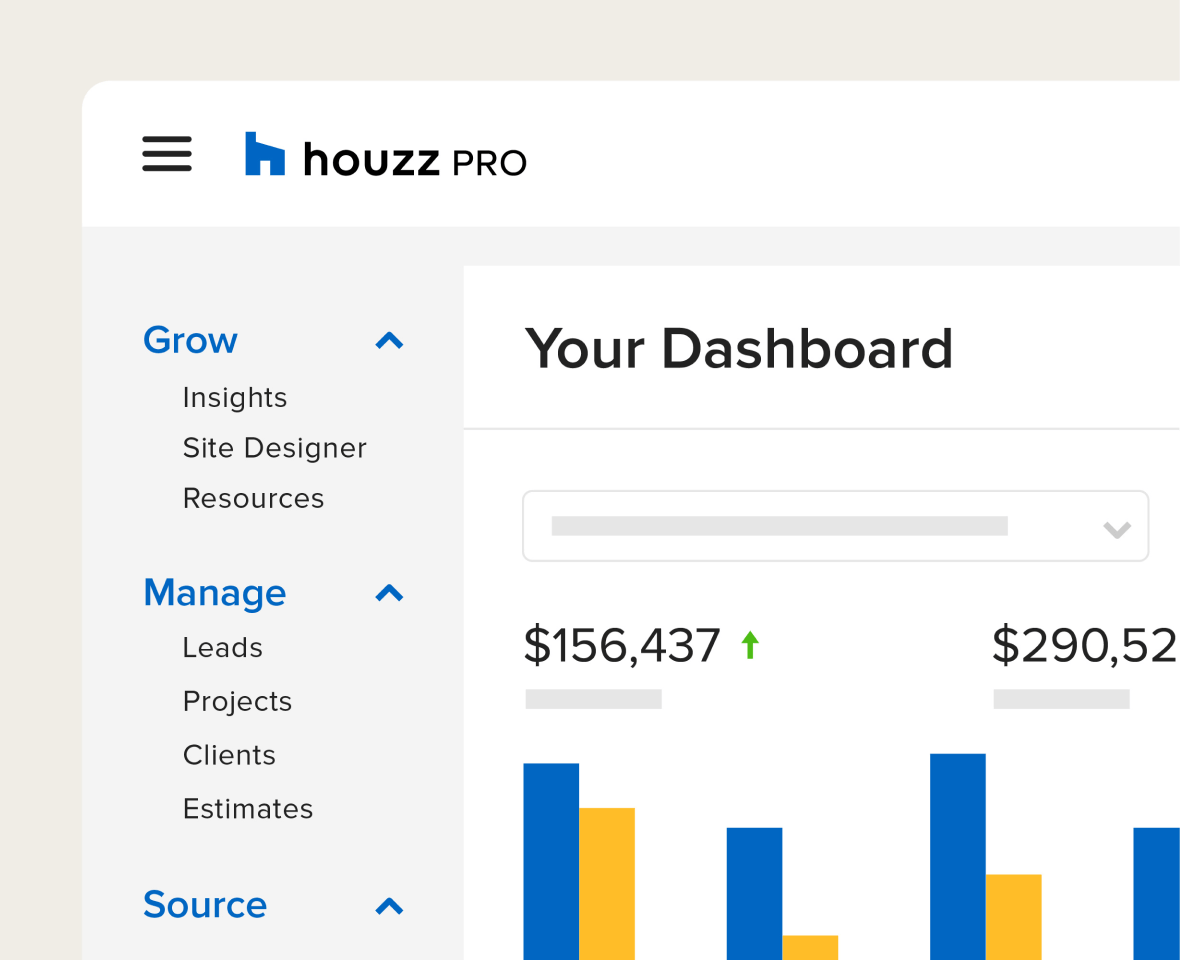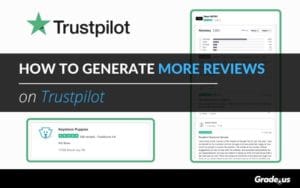Houzz is a thriving community with more than 40 million homeowners and more than 1.5 million home improvement professionals. So you can imagine the value of Houzz reviews for any home services business.
The founders behind the website were motivated by pain.
Adi Tatarko and her husband, Alon Cohen, struggled to find the right professionals to build their dream home. They essentially gave up after spinning their wheels for a year. Houzz was born out of their frustrating experience, becoming an incredible online platform for homeowners and home improvement professionals.
In this home services industry post, we’ll cover:
- Why Houzz is important to your home improvement business
- Who visits Houzz?
- How Houzz compares to other review platforms
- What your goals should be on Houzz
- Creating your profile on Houzz
- Optimizing your Houzz profile
- Requesting and tracking reviews on Houzz
- Your Houzz point-of-contact
- Goal tracking via Houzz
- Advertising and selling products on Houzz
Why Houzz is important to your home improvement business
They’re unique for one important reason.
It’s all about the user.
From the beginning, Adi and Alon focused exclusively on the user experience. They wanted to provide their users with the very best. This may not sound significant, but it is for several important reasons. Adi and Alon:
- Resisted pressure from investors to monetize the site in favor of building a strong community.
- Used the community to further foster brand loyalty and trust.
- Geared every decision around delivering the best home renovation and design experience.
- Demanded high-quality standards from merchants, professionals and partners.
- Terminated relationships with professionals.
These methods are how Houzz became the world’s largest residential renovation and design community. They’ve focused obsessively on taking care of their users.
This is a two-edged sword.
If you’re a high-quality home improvement professional who goes above and beyond, then Houzz is the place for you. If you’re a professional who makes serious mistakes or consistently fails to provide an exceptional experience and incredible value, you’ll be out the door.
Why is that?
Houzz has conditioned its community to expect the best.
Who visits Houzz?
Houzz’s user demographics are diverse. There’s a mix of homeowners, enthusiasts, professionals and merchants on the site. The emphasis, however, is on homeowners. Here’s a brief breakdown of Houzz’s user demographics.
- 40 million homeowners on Houzz.
- 90% of Houzz users are homeowners.
- 84% of these homeowners plan to purchase a home product or service in the next six months.
- 71% plan to renovate or redecorate their home.
- These homeowners are active on Houzz, relying on them to renovate and decorate their homes from start to finish.
- 72% of Houzz users are between 25 and 54 years old.
- Houzz has users in the 18 - 25 age range, but these users are more likely to be renters.
- There are 1.5 million active home improvement professionals on Houzz.
Contrast this with Yelp.
Yelp has 138 million visits, but the majority of these users are focused on a variety of services. They aren’t home enthusiasts, so from a lead generation standpoint, the quality isn’t as high as the users received on Houzz. Their visitors are able and willing to pay for the products and services displayed on the platform, provided that the reviews are there.
How Houzz compares to other review platforms
Mainstream providers are important, but Houzz is an essential platform for home improvement pros. Mainstream platforms provide brands with quantity — more traffic. Houzz provides pros with quality. Here’s how Houzz compares to mainstream platforms.
Houzz is a gold mine.
But you wouldn’t know it from the angry reviews posted online. Visit sites like the BBB, Trust Pilot or Sitejabber, and you’ll see reviews from angry home improvement professionals who spent a significant amount of money but ran into one of three problems.
1. Poor lead volume
2. Steady leads, but not enough of them convert
3. Poor lead quality due to multiple pros receiving the same leads
If you’ve run into these issues as a home improvement professional, it makes complete sense that you’re angry. If you invest a significant amount of your time and money on a platform, it’s reasonable to expect a return on your investment. Many pros aren’t getting it though.
This requires a change in expectations.
What your goals should be on Houzz
Houzz is a diverse platform. You can accomplish more on this platform than you can with other mainstream or niche platforms. Here’s a concise overview of the goals and objectives you can take on Houzz:
- Online reviews from happy customers that convey trustworthiness demonstrate value and defuse objections. Aggregate reviews from Houzz are visible in Google’s search results so their platform has a significant impact on the returns you’ll receive.
- Phone calls from customers who are interested in speaking with someone at your company directly. This is often an attempt, on the customer’s part, to qualify or disqualify your company. As a home improvement pro, it’s also an opportunity for you to do the same.
- Online visits from your Houzz profile directly to your website. If you’re looking to generate leads and win customers with these online visits, it’s a good idea to direct customers to a specific landing page that’s designed to tag customers with a tracking pixel, generate a lead, or make a sale (unlikely).
- Leads. Contact information from a qualified prospect – on Houzz, this could be someone who would like to request a quote or proposal for your services. It could also be a customer who’s interested in purchasing a specific product from your store via Houzz. Leads are context-specific and dependent on user intent.
- Sales revenue derived from your products (if you’re a merchant) or your services (if you’re a pro). You provide customers with the specific product, service or consultation they need. They pay you for your product, expertise or time.
- Trade and Business. Trade is a Houzz program that’s exclusive to Houzz professionals. It allows you to earn credits for referring products to customers. You’re then able to use these credits to purchase products on Houzz at a discount. Houzz Business is a free program that allows businesses discounts, up to 50 percent off, on retail-priced purchases on Houzz.
Houzz approaches these traditional goals a bit differently than other platforms, as you’ll see later in this post. These programs require a Houzz Pro account.
Creating your profile on Houzz
Creating your profile on Houzz is easy and uncomplicated. Here’s how you do it.
1. Visit Houzz.com/signup/
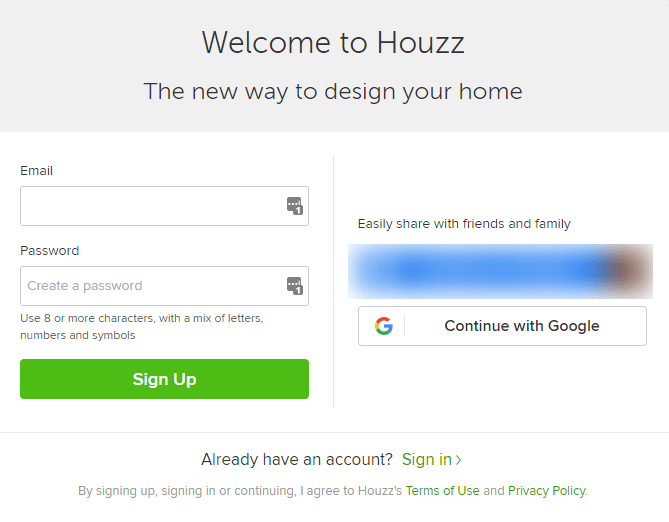
2. Click professional if you offer home improvement services or sell home products.
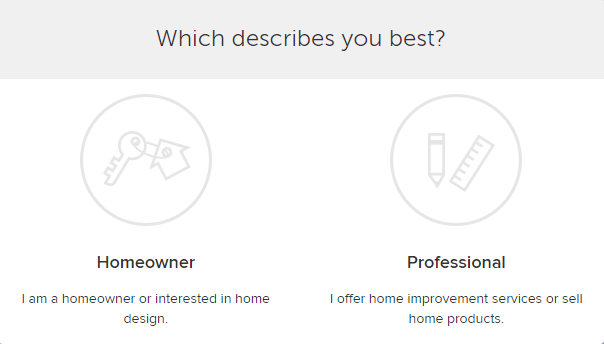
3. Enter your business information. Houzz will ask for your company name, category, type, address and phone. Make sure the “make private” box is unchecked.
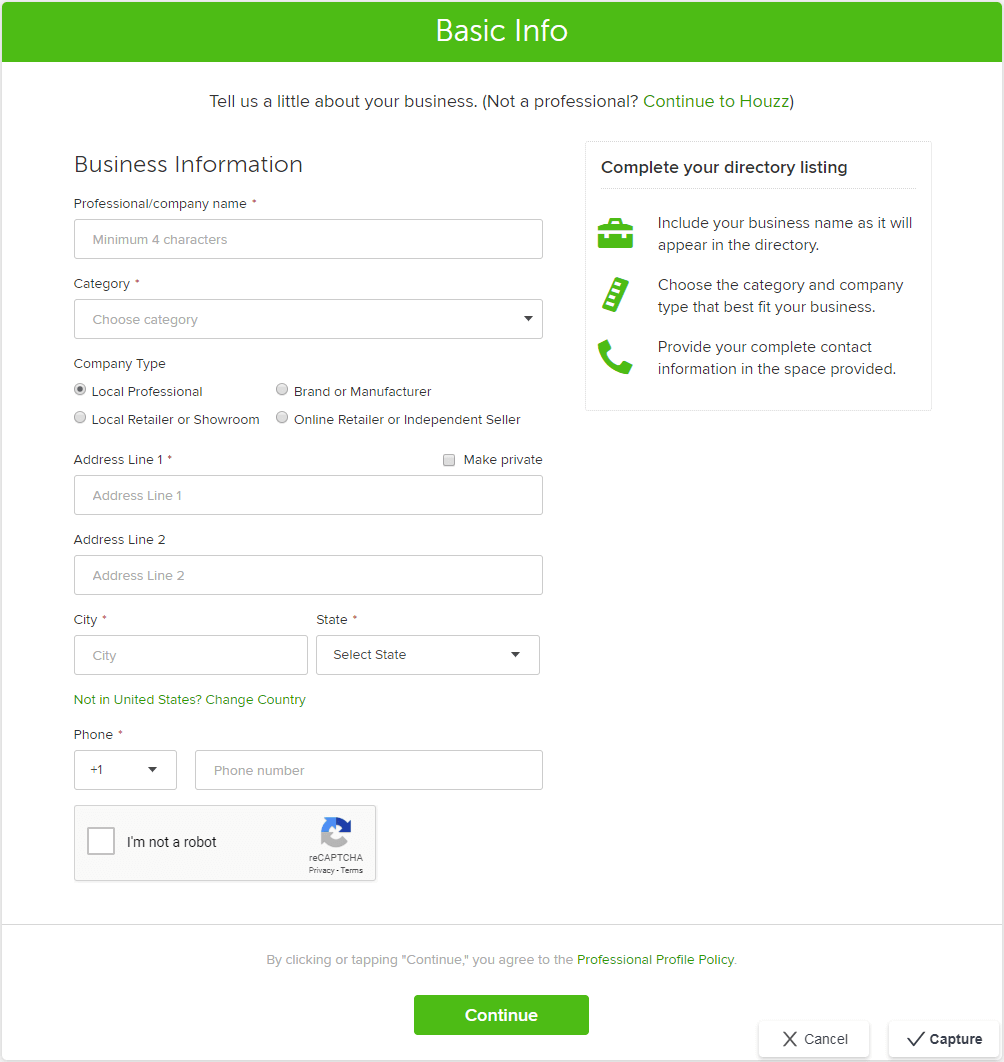
4. Check each of the services you offer in your category.
5. Add your business details — website, license number, business description, certifications and awards.
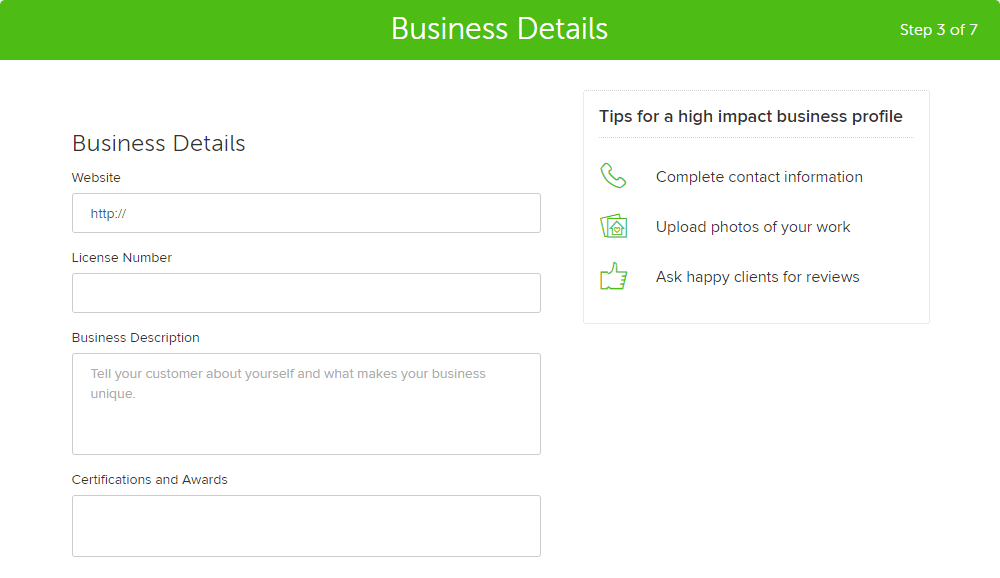
6. Enter a price range and cost details so clients understand your budget requirements.
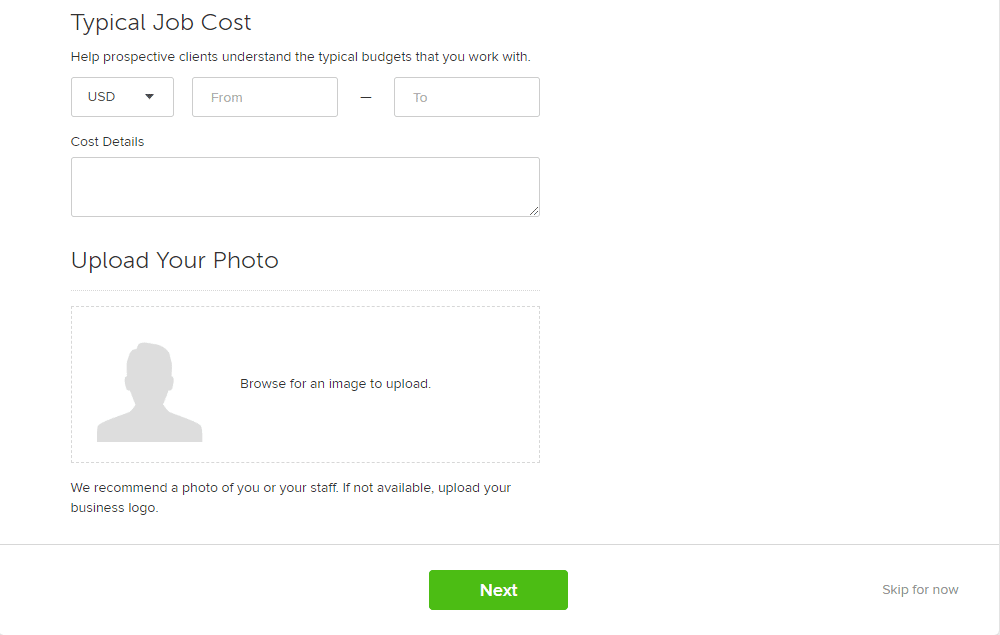
7. Determine whether you’re ready to advertise on Houzz (you can do this later).
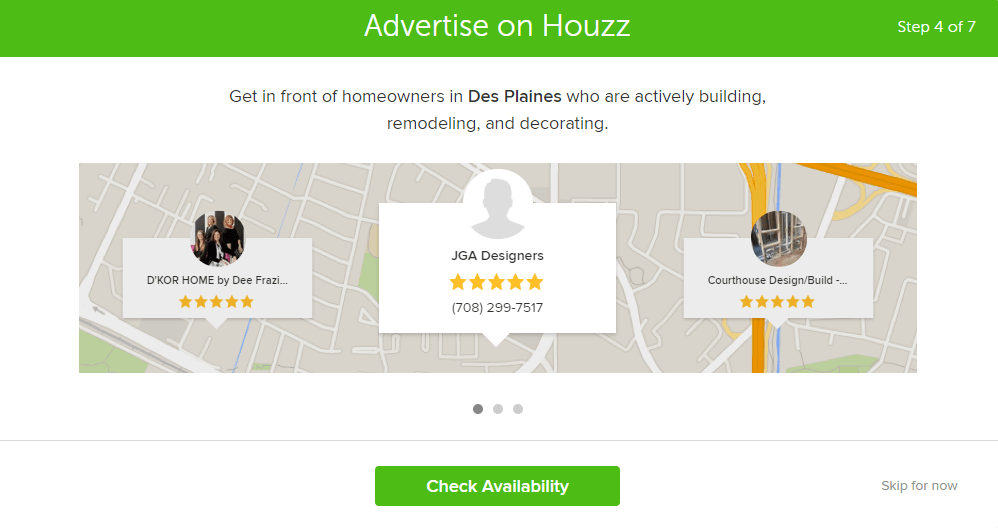
8. Import contacts and request reviews. Add contact email addresses and customize your review request message. Here are 44 review request email templates that you can customize.
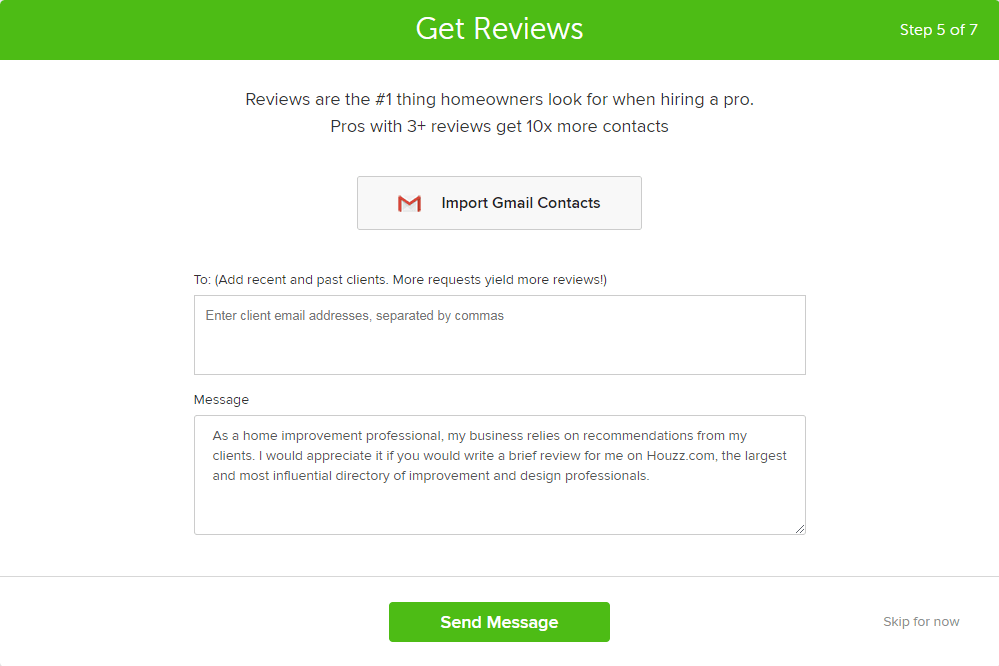
9. Choose to enroll in Houzz Trade (or decline). It’s free. You can also skip this step.
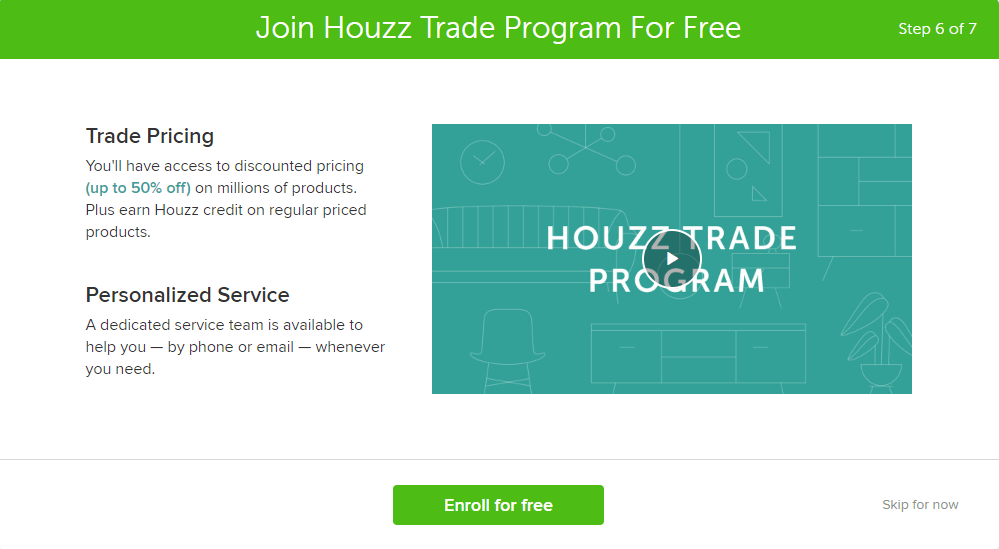
10. Create your first project and add it to your portfolio. (You can come back to this step later)
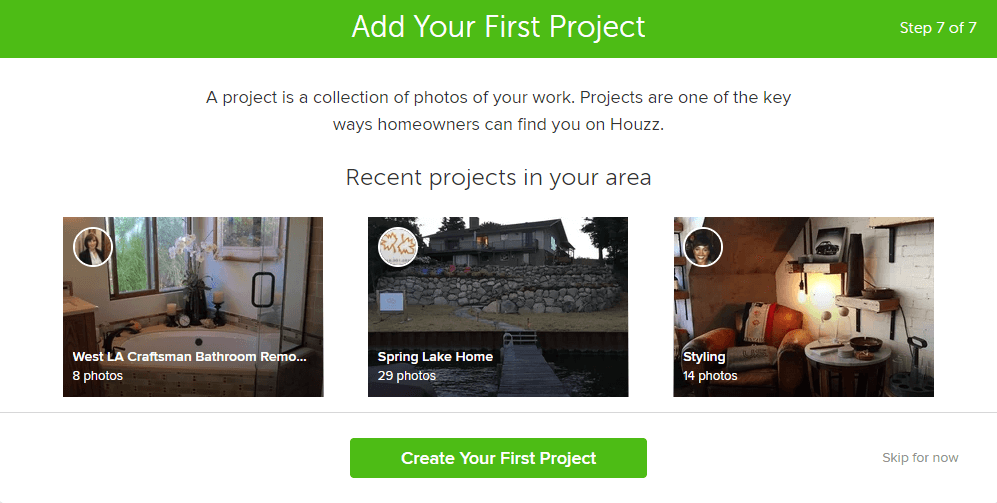
11. Add your project name, address, category and details.
Here’s an example of a fully fleshed-out Houzz profile.
You’ll want to ensure that your Houzz profile is complete, has lots of photos, projects and reviews. This establishes surface credibility and keeps you in the running with prospects.
Optimizing your Houzz profile
This is where most professionals on Houzz go wrong. They allow Houzz to set their expectations, which, as we’ve seen, is a recipe for disappointment and frustration.
Here’s what I mean.
Platforms like Houzz can be used in one of three ways.
1. Attraction. A Houzz profile that’s complete, optimized and consistently maintained produces a modest return. A well-maintained profile with third party credibility and promotion produces a large return. If you have all of the above and you’ve established authority and credibility, you attract a disproportionate return. You receive the lion’s share of the traffic, leads and sales generated in your market.
2. Conversion. A completed profile acts as a persuader. A Houzz profile that’s optimized converts customers who are looking to validate or falsify your claims. They convince customers who are on the fence to buy into your service or purchase your product. It’s yet another form of social proof that boosts your credibility and authority in the marketplace.
3. Consumption. A completed profile — complete with reviews, projects and ideabooks — increase consumption. Active customers with consistent renovation plans spend more with your firm when you provide them with consistent education. It’s an opportunity for customers to sell themselves, to daydream about what’s possible.
Optimizing your Houzz profile is simple.
Make sure it’s complete. Go through each of the categories listed in your profile — projects, idea books, reviews and questions — and add content. Doing this boosts credibility which, as you’ll see, is an important criterion if you’d like to generate leads.
When it comes to credibility, there are four types:
- Earned credibility: Your visitors have had a positive experience with profile or website (e.g., helpful information, little to no errors, expert advice, great customer service, etc.). They found your profile and marketing to be both credible and valuable.
- Reputed credibility: A referral from a 3rd party - Houzz, your family, friends, a co-worker, someone you know or unbiased reviewers who have had a positive experience with your business.
- Presumed credibility: Familiarity and assumptions - a brand that customers have heard of is more credible than an unknown (e.g., I saw your Houzz profile, I saw your video on HGTV, I listened to your interview on This Old House, etc.).
- Surface credibility: A visitor's subjective opinion of your brand (e.g., I like the design, they look trustworthy, they have great content, this page is confusing, etc.) which is all that matters when you're asking them to convert.
This is why it’s so important for Houzz professionals to complete their profile. When you neglect this, it’s a shot to your credibility.
What does it mean to complete your profile?
- Complete all categories
- Use high traffic keywords to drive traffic to your profile pages
- Tag products
- Share your blog posts on your Houzz profile
- Consistently request reviews from customers
It’s simple, concise and easy. What does a fully optimized profile look like? To answer that question, we’re going to take a look at Creation 7, an award winning design firm.
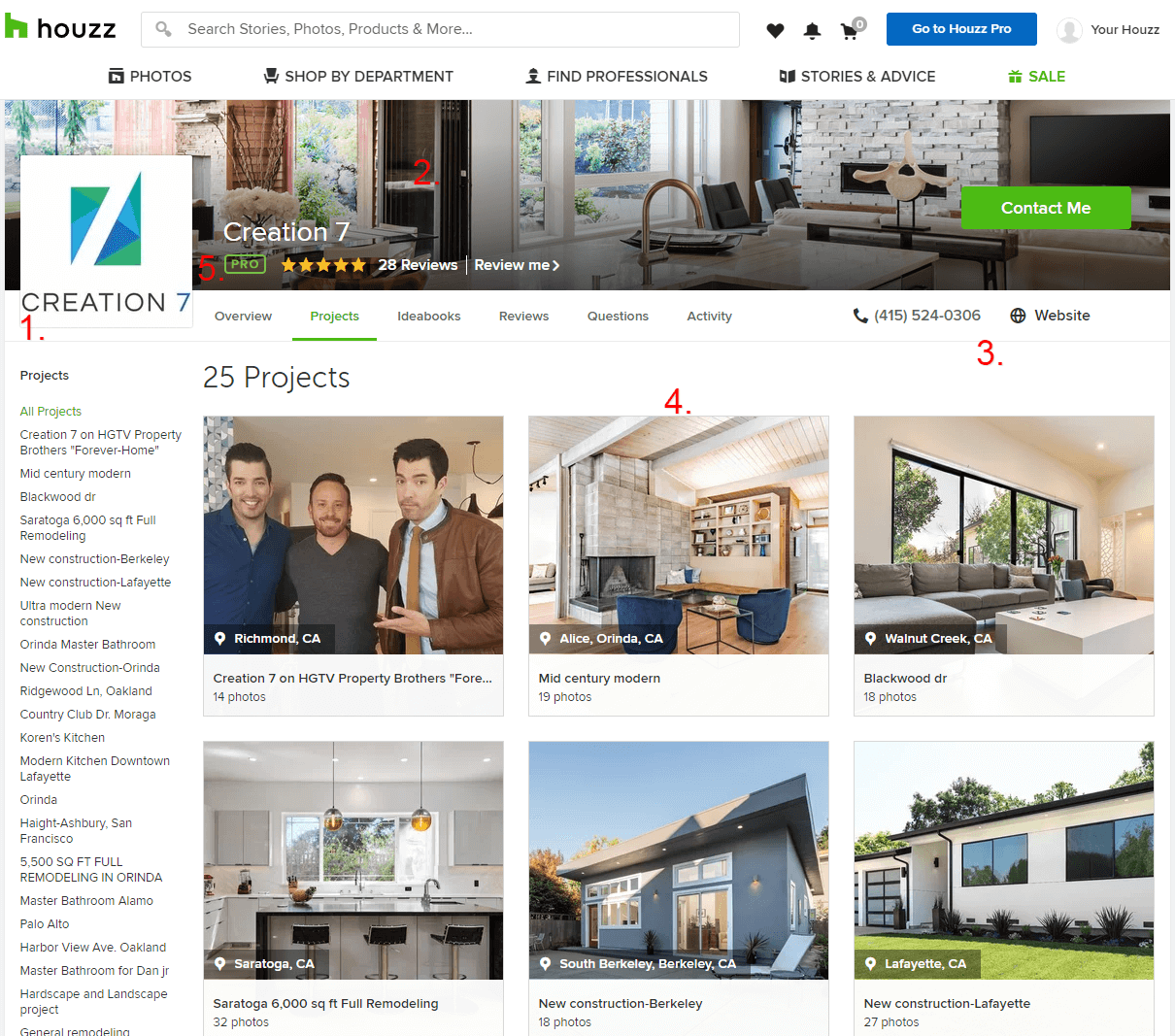
Let’s take a look at the items labeled in this first photo.
1. Logo or headshot. Creation 7 opted to include a high-quality image of their logo to represent their organization. This is significant because, as a platform, Houzz is focused on quality.
2. Cover photo. A high-quality cover photo to reinforce the quality and consistency behind their brand.
3. Contact details. A phone number and website link to a site that actually works. You’d be surprised at the number of website links that take visitors to a parked GoDaddy domain or a disconnected phone line.
4. Projects. A list of projects with beautiful, well-lit and inviting photos. These project photos and the details that go with them convey so many intangible and unspoken details about your brand. The most interesting part about this? The very first project includes a photo with the Property Brothers, giving Creation 7 a giant shot of credibility.
Let’s take a look at Creation 7’s overview.
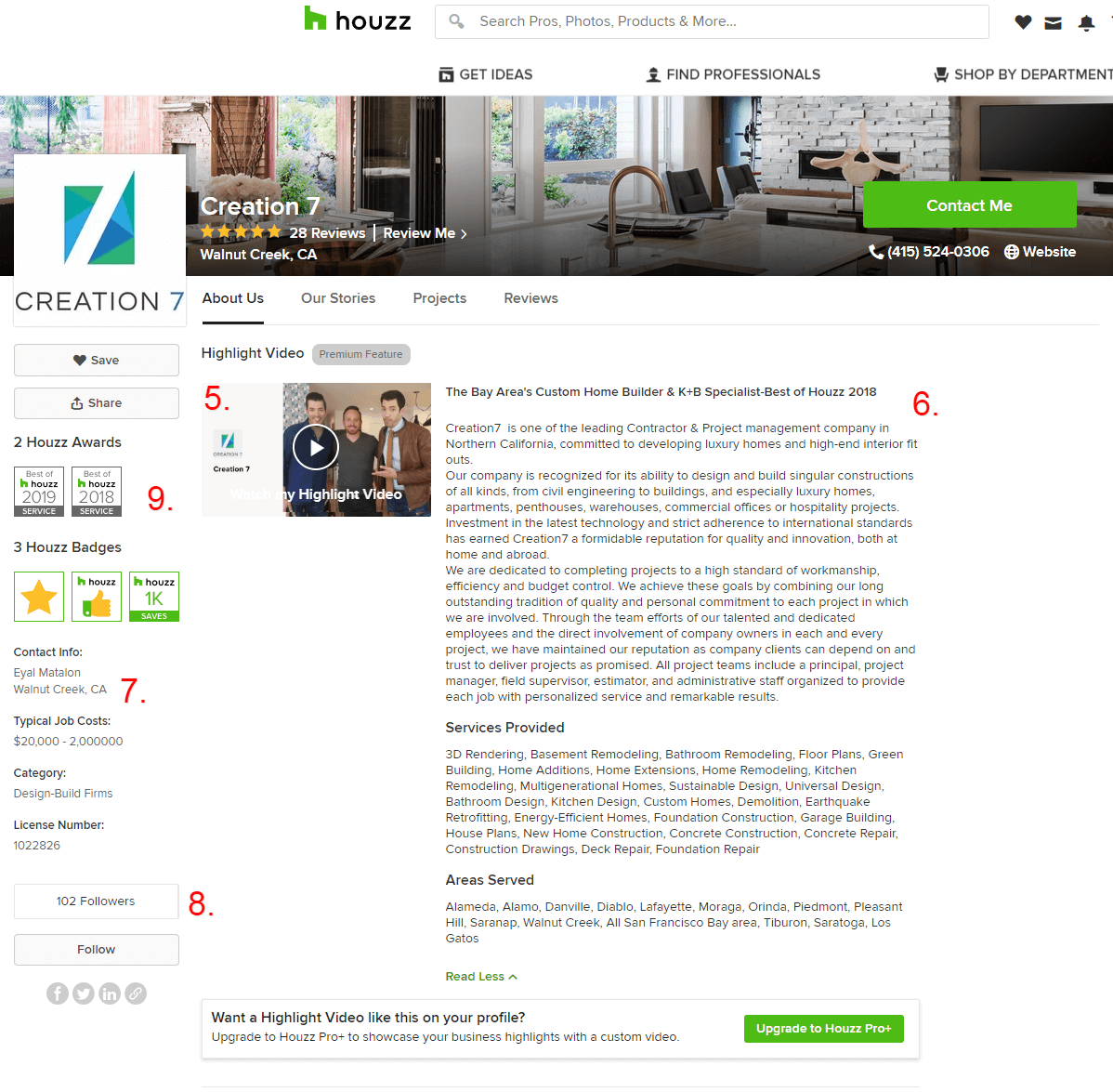
5. Highlight video. Creation 7 upgraded to a Houzz Pro account, so they’re able to create a highlight video that gives users a brief overview of their work.
6. Comprehensive description. Which detail in your story is most important to your prospects? No one knows. That’s why it’s important to tell the whole story. Creation 7 does this beautifully, and their description strikes the right tone with luxury buyers who are primarily focused on presentation since quality and value are already assumed.
7. Business information. This company lists their address, typical project costs, categories and license numbers. This is crucial information that’s ignored on far too many Houzz profiles.
8. Follower counts. Slowly but surely, Creation 7 is building an audience on Houzz. This is important because an established audience gives them control over the growth and financial future of their organization.
9. Award winning brand. Awards are important, especially in the luxury space. It says, “this company isn’t like the other companies on Houzz.” This is especially appealing to buyers with a high net worth who are looking for the best.
What about reviews?
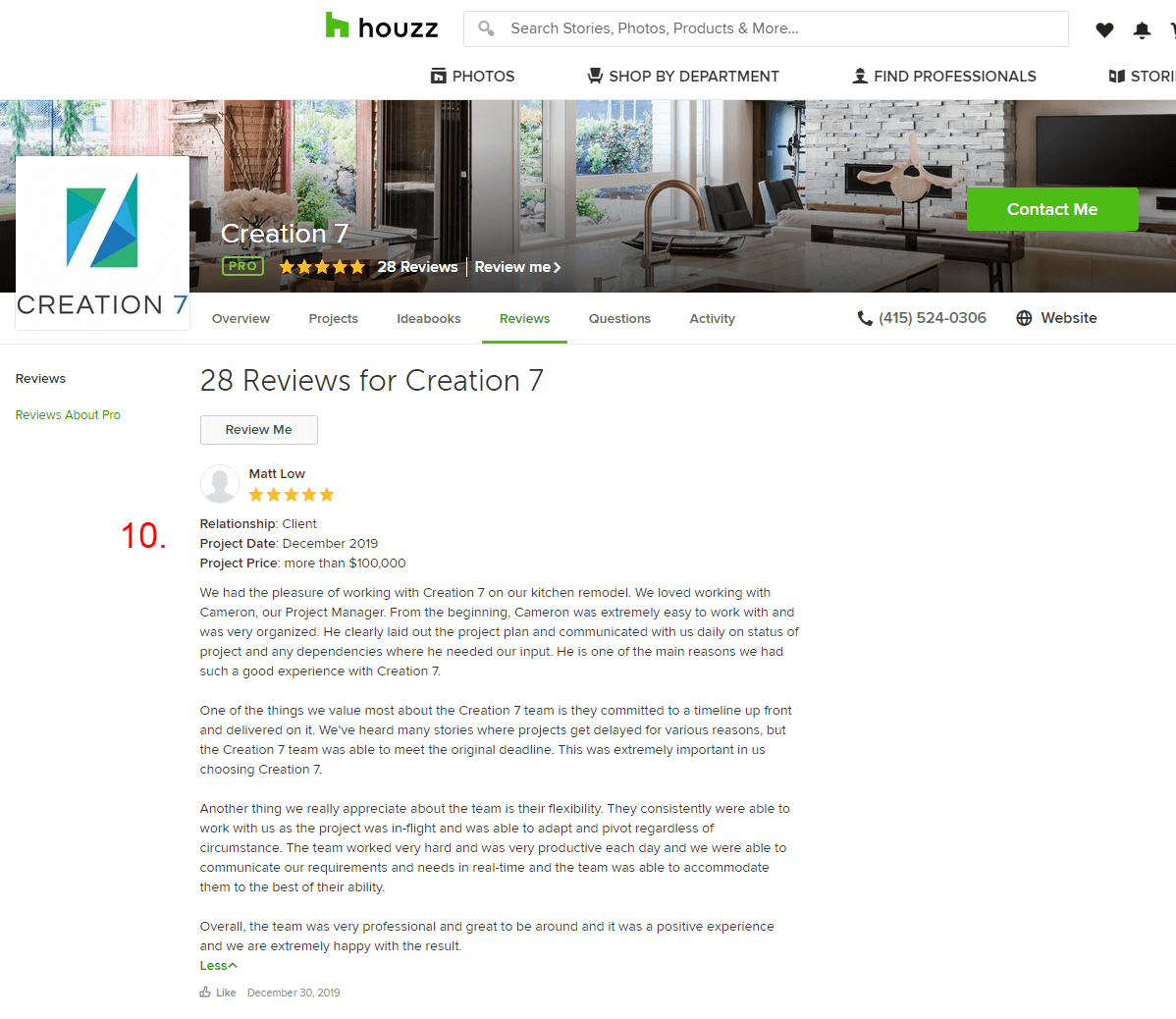
10. Reviews. Several things stand out in this review. This customer is happy. They hired Creation 7 and they delivered results, on time and in-budget. They communicated with clients clearly. They did so daily. Creation 7 was flexible and able to adapt to changing circumstances.
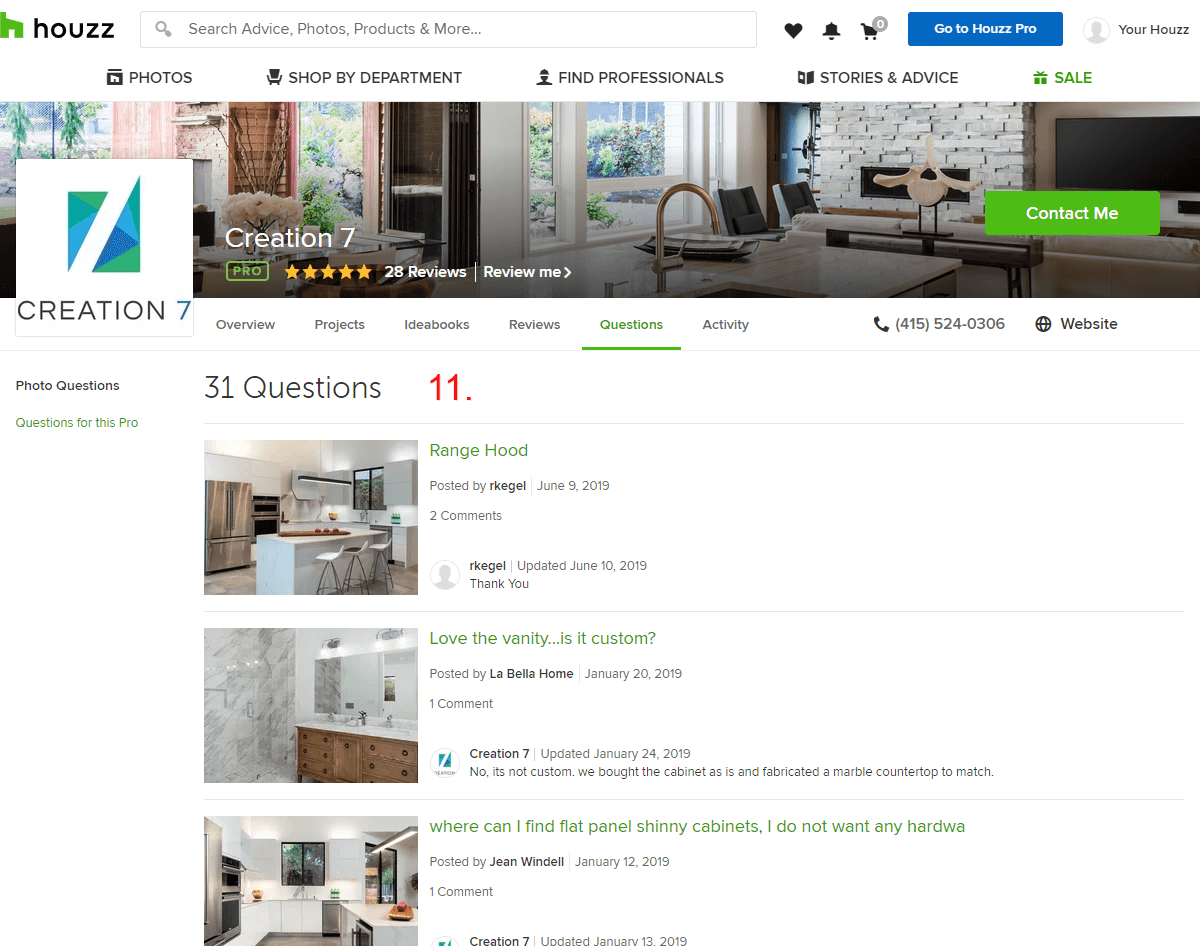
11. Questions. Houzz users often have questions for professionals with popular profiles and engaging content. This is no accident — this kind of interest can be generated via credibility and authority, minor celebrity, or simply engaging with others on Houzz. These questions are implicit notifications to lurkers on your Houzz profile that you are no ordinary professional. This is yet another way to boost credibility and performance on your Houzz profile.
See what I mean?
Profiles like these are no accident. They’re engineered to maximize appeal and prestige. They create demand, showing prospective customers that you are the professional they need. Wow them, and you’ll find this early groundwork has primed them to leave a positive review on your profile.
Requesting and tracking reviews on Houzz
Reviews are an important part of marketing on Houzz. A strong review profile makes a significant impact across their platform. Here’s how they describe it.
“Ever wonder how Houzz determines the order of professionals in our directory? It’s based on an algorithm that takes into account several factors, including the number and quality of photos in your profile, the number of questions you’ve answered, whether you sport a Houzz badge on your own website, and whether you have reviews from past clients or other professionals with whom you have worked. Along with helping contribute to your directory rank, recent reviews from clients can also put you in the running for the annual Best of Houzz Service award.”
This means reviews aren’t simply a one-time occurrence. If you’re a professional on Houzz, it needs to be an ongoing strategy. Here’s how you request reviews on Houzz.
1. Log in and go to your professional profile and click the “Get Reviews” link in the cover photo.

2. Enter the email address of the person you want to review your business.
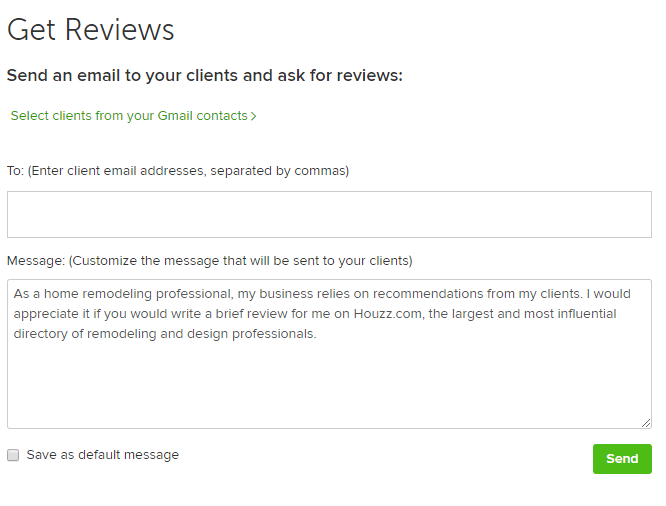
3. Write your message. There is a default message in the Request Message box, but you can and should customize it for each client. To customize the request, reference what you enjoyed about the project and suggest specific aspects of the project that your client could write about in the review.
It’s that easy.
Here’s some more good news.
“Each client is allowed to write one review for the professional. Our team reads all reviews for authenticity, so it may take a few days for the review to show up on your Houzz profile after your client submits it.”
If you’re using a third-party review platform like Grade.us, review management can be handled and tracked remotely. Here’s a list of the third-party review platforms covered by our platform.
Start Generating Amazing Houzz Reviews
Your Houzz point-of-contact
Houzz funnels the vast majority of their customer support traffic through their contact form and self-service FAQ. Here’s a list of the methods you can use to get their attention if needed.
Here is a list of phone numbers for Houzz. Keep in mind that these numbers may change frequently.
- (800) 368-4268
- (800) 368-4268
- (916) 445-1254
- (800) 952-5210
- (800) 326-2297
- (916) 322-1700
- (650) 326-3000
Email:
Address:
285, Hamilton Ave. Palo Alto, CA 94301-2537
You may need to request a transfer or redirect to get the help you need if you can’t reach someone. Some reviewers state that it can be difficult to get a hold of someone when you need it. You’ll need to determine if that rings true for you.
Goal tracking via Houzz
Houzz provides professionals with Houzz pro, a dashboard that offers data on:
- Leads
- Inquiries
- Site Designer
- Resources
- Projects
- Source products
- Source by category
- Source by brand
As a project management platform, Houzz works well for many home improvement professionals, though they’re heavily slanted towards design and construction-oriented specialties.
Is this all the tracking you need?
Not by a long shot. You’ll still want to integrate Google Analytics (or your platform of choice) into your website. You don’t want to take Houzz’s word for it that you’re generating leads, you want to audit what they’re telling you in real-time, verifying that you’re getting a return on your ad dollars.
This requires link tracking via your profile, project descriptions and photos.
You can add tracking parameters to your URLs to make things more clear in your analytics dashboard. One of those is the referral parameter. Here’s an example:
www.yourbusiness.com?ref=houzzprofile
The text after = could be whatever descriptor you choose — ref=houzzproject4971 or something a bit more descriptive, ref=houzzprojectwadehouse. Just make sure that your descriptors are descriptive and consistent, so they’re properly represented in your profile data.
What about project links?
This requires a bit of HTML to work properly. You’ll need to use/modify the following tag:
<a href=”http://yourwebsite.com/?ref=houzzprojects“ target=”_blank” forbidden_rel=”noopener”>http://yourwebsite.com/</a>
When you see “houzzprojects” or “houzzprofile” in your Google Analytics acquisitions reports, you’ll know these visitors came from specific sections on your Houzz profile. This simple tracking provides you with the third party validation you need to verify whether your Houzz profile is truly selling for you (or not).
Advertising and selling products on Houzz
Houzz offers a variety of marketing products on their website. Let’s take a look at each of them.
Advertising
Houzz offers two forms of advertising; one geared towards local businesses, the other focused on national brands. If you’re a local home improvement professional, you’ll probably be best suited for local advertising. If you’re a product merchant, manufacturer or large brand, you’ll do better with national advertising.
Houzz Pro
It is an upgrade to their basic profile.
The pricing varies somewhat based on your specialty (which they show you upfront). Here’s a list of the features included with Houzz Pro.
These tools give your home improvement company a leg up against your local competitors. What’s nice about all of this is the fact that Houzz Pro can be paid on an annual or monthly basis. This means you’re able to see results before spending a significant amount of money.
Selling products on Houzz
Houzz has very stringent requirements for its merchants. If you’re a product merchant looking to sell products on Houzz, you’ll need to reach out to them directly via their contact form. If accepted, you’ll need to ensure that your product listings meet their seller guidelines.
Here is the obvious part pros miss.
The demand for your services depends on your market. If you serve smaller markets and you’re unable to serve a major metropolitan area, you won’t see a significant amount of demand for your services. This sounds obvious but it’s tough to keep that in mind if you’re told otherwise by an eager salesperson.
Here’s another important point.
If you do what others do, you’ll get what others get. If you create a Houzz profile, but you do the bare minimum, you won’t see the results you want. With that in mind here are some steps you can take to amplify the effectiveness of your Houzz profile.
Step #1: Target high traffic keywords
The wonderful thing about Houzz is the fact that their website has a significant degree of credibility. As a top tier property online, Houzz has a lot of trust with Google. It’s easier for Houzz to rank for specific keywords than say, a small mom and pops contracting firm.
Use this to your advantage.
Head over to Google Keyword Planner, Ubersuggest or your favorite keyword tool and start building out a list of keywords your customers use to search.
You’ll want to target the following keyword types:
1. Informational keywords: Keywords that communicate interest or desire to be educated on a specific topic.
2. Navigational keywords: These are keywords for a specific brand, product or person in the marketplace. These searches are common once customers are familiar with who you are. (green hill interior design)
3. Transactional keywords: These keywords signal an intent to buy or convert. Keywords like “Interior designer Chicago” or “green hill interior design quote” show customers are ready for the next step.
Step #2: Dominate your categories
You’ll want to optimize your Houzz profile using the strategies in this post, to dominate your profile. Work to increase your organic rankings in each of the categories you’re pursuing on Houzz. Optimize your photos so local searchers can find them. Do everything you can to ensure your profile is nurtured and cared for.
Step #3: Create more content
Did you know you can write for Houzz?
You can. Here’s a snapshot outlining what they’re looking for.
How can I write for Houzz?
The ideabooks featured on the Houzz homepage and newsletter are written by the Houzz editorial staff and freelance design writers. Contributors write at least once a week on a wide range of home and garden topics.
If you’d like to be considered for a weekly contributor, please email us at [email protected]. Tell us about your particular interests and experience in home improvement and design, and include links to your three best writing samples
This raises your profile considerably. You’re not just any designer or contractor. You’re a contractor Houzz trusts enough to feature prominently on their website. This is yet an opportunity to put their domain trust to work for you.
Remember your keyword list?
You’re going to create content searchers want, using keywords they’re already using in Google. Houzz will rank well for these keywords, but it’s your name and company that’s featured in the article itself. All of this leads back to your Houzz profile and website.
It’s a win/win all around!
This has a compounding effect on your advertising and marketing on Houzz. These tactics are simple, but they’re also the details that most professionals on Houzz won’t do. For many, it’s simply too much work.
Step #4: Amplify with offsite marketing
Don’t let your website visitors get away!
Lure them back with remarketing. You can tag them with a tracking pixel, then send them helpful content on Facebook or Google. Here are some examples of helpful content you can use to win these prospects over.
- Helpful checklists - The Home Renovation Checklist Homeowners Need but Have Never Seen
- Anchor reviews from happy customers - "Dare Designs did a phenomenal job on my kitchen renovation project! Highly recommended."
- Enticing offers - Customers who contact us by X date will receive Y with their order.
This is how you maximize the value received from your Houzz profile.
While many home improvement professionals are sitting back waiting for the leads to pour in, you’re working. You’re constantly cultivating opportunities and adding value to those around you.
Houzz is a secret weapon in the right hands
Savvy home improvement professionals see the value that comes with Houzz. Most professionals sign up for Houzz, then they wait. They treat the platform as a passive provider, a goose that lays golden eggs.
Houzz provides golden eggs, but it requires work.
You’re a professional, you know it takes consistent effort, going above and beyond to generate outstanding results. This is what you need to grow your home improvement business.
Houzz is a thriving community with more than 40 million homeowners and 1.5 million + home improvement professionals. There’s more than enough opportunity there for the pros who want it most.
Is that you?
Make it about your customers. Focus exclusively on maximizing the value you provide to each and every one of your customers. Then work to capture a percentage of that value. You’ll find Houzz has everything you need to build a thriving and powerful home improvement business.

